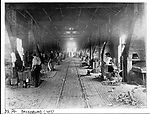 Large Chain Shop
Large Chain Shop Feel the Heat
Feel the Heat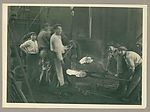 'ommer it!
'ommer it! Ready to Go
Ready to Go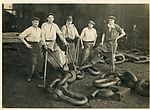 We Made This
We Made This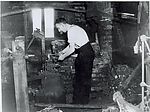 Small Chain Shop
Small Chain Shop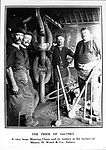 Tools of the Trade
Tools of the Trade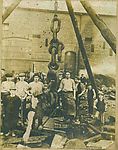 Children at Work
Children at Work Breeze Oven
Breeze Oven

The factory system of chain making began in the early nineteenth century as a result of the success of cable-chain, and the subsequent demand from the Navy and merchant fleets. The Black Country was the ideal location, as it had an abundant supply of good quality wrought iron and coal.
Noah Hingley is credited with bringing large cable-chain manufacture to the Black Country, when in the 1820s he won an order from a Liverpool shipowner. The early factories began as small workshops attached to the employers house, employing workers from outside to help them. As business expanded they would move to larger premises, although out-workers were still used as and when they were needed.
Hingley’s of Netherton paved the way for others to establish large scale chain manufacture in the region, and by the end of the century thousands of people were employed in factories across the Black Country. By 1866 some 60,000 tonnes of chain were being made each year, much of which was being exported around the world.
A chain shop would have an hearth for each chain-maker together with all of the tools of the trade. Makers of small chain worked alone, but those making large chain would have up to three strikers working with them, who would wield the large hammers whilst the Smith, the team leader, held the tools. Under the butty system, only the chain-maker was directly employed whilst the strikers were paid by the chain-maker. The chain-makers who worked on large chain began work early in order to avoid the heat of the day, and it was not uncommon for chain-shops to be deserted by midday.
The fuel used to heat the wrought iron to welding temperature was known as breeze. This was coal that had been burnt without oxygen; what we would know today as coke or smokeless fuel. This fuel was produced in a breeze oven by breeze burners and ovens like the one in the picture could be seen all around the district. The breeze was washed prior to delivery to the chain-shop as a clean fuel was needed to prevent contamination of the iron.
Sometimes pieces of partially burnt coal called “gleeds” were used. These would come from the many fires and furnaces in use in the area, and would be separated from the ash by throwing shovelfuls onto water, the “gleeds” floating to the surface.
Breeze needed a good blast of air to keep it hot enough to heat the iron so each hearth was fed with a supply of compressed air. This may have come from bellows in a smaller chain shop, the larger works being fed by compressed air produced by a steam engine
Women were restricted to making chain from rods of up to 3/8in (10mm) diameter. This restriction was an agreement based on the principle that the women’s work should not threaten the job security of the men. Men would make chain made from rods of up to 6ins (150mm) diameter. Generally the chain made by women would be for agricultural, domestic or architectural use, whereas that made by men was more likely to be that used for ships' cables, cranes, pulleys and any other usage where safety was an issue. Children were used in the workshops, usually to operate the bellows for the blast, although some were employed making small chain.
A small employer may only have employed six people, mostly doing work for one of the larger companies. The largest companies employed up to one hundred people on chain-making, although many hundreds would have worked on a wide range of products that the company diversified into. Sometimes several members of the same family would work at the same factory and would do so for their entire working life. In 1866, 2,000 men and boys were employed in 235 factories. Wages were based on piece-work, with those making the largest and best quality chain earning the most.
It was often the case that the only way to learn the trade was for the skills to be passed on from father to son. Some firms operated an apprenticeship scheme, which would involve the signing of a formal legal indentured seven year apprenticeship agreement. As well as the agreement on pay and conditions, it was not uncommon for it to stipulate that the apprentice, "shall not haunt taverns or ale houses" and that he "shall not play cards or dice".
Rollover the captions in the box to see the available images in thumbnail format, click the caption to see the full-size image
| Reference: | 657 |
| Keywords: | |
| Archive Ref: | |
| Updated: | Wed 21 Mar 2007 - 1 |
| Interpretation written by | Louis Howe |
| Author's organisation | Curatorial |
| Organisation's website | |
| Contributor | Chain & Anchor Making in the Black Country by Ron Moss |
| Contributor | Netherton Breeze Burners by Terry Willetts Blackcountryman Vol 11 no.2 |
| Contributor | Image 9 Terry Willetts Black Countryman Vol 11 No.2. |
| Contributor | Chains & Chainmaking by Charles Fogg |
| Contributor | Images 1-8 Courtesy Black Country Society |